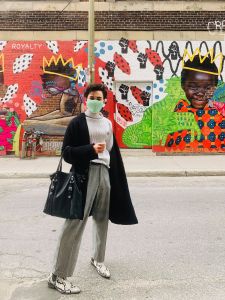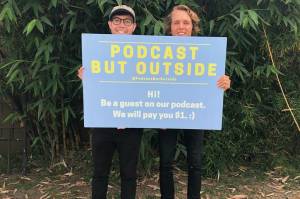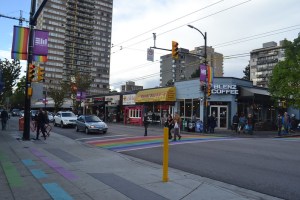Recently I’ve been thinking a lot about Greta Gerwig’s films, and what makes her such a compelling force on-screen and behind the camera. The one constant which seems to pervade Gerwig’s works is her ability to capture what Stanley Fish terms the “variorum:” the infinite ways in which individuals process and interpret artistic documents. In Fish’s formative essay, “Interpreting the Variorum,” he applies this term to reading, arguing that readers employ “interpretive strategies” which inform the way that they interact with and interpret a given text. More broadly, these interpretive strategies reflect the ways in which individuals interact with the world around them, and are informed by each individual’s habitus—the social, economic, and physiological elements which make-up their identity and character. In her cinematic career thus far, Gerwig has not only continued to emphasize the formative power of these interpretive strategies but has also successfully communicated the personal experience of ushering these strategies into existence. In Lady Bird, this process of interpretation is documented through the film’s main character, Lady Bird (Saoirse Ronan), and the evolving ways in which she relates to and envisions her home town of Sacramento.
Sacramento retains a rural integrity which contrasts its heterogeneous roots, displaying a unique blend of small-town community and fervent Catholicism amidst the democratic-leaning state. The film begins with an acknowledgment of this duality, as Lady Bird and her mother Marion drive along a pastoral road discussing the seventeen-year-old’s options as she considers which colleges to apply to in the upcoming semester. While her mother amiably looks ahead towards the Sacramento skyline, contented by the pleasant tranquillity of her surroundings, Lady Bird sits with her eyes narrowed into a slit, directing all of her malice into the foregrounding shot. As the scene progresses, Lady Bird passionately declares her desire to flee the small town for larger East-coast horizons, exclaiming, “I want to go to the East Coast… I want to go where culture is, like New York..!” Whereas Marion views Sacramento through the guise of all the small comforts and economic benefits that the city provides for her and her family, Lady Bird associates the city with a lack of opportunity and potential for artistic growth. This initial rift illustrates the characters’ differing interpretive strategies, as informed by their differing habitus’, thus foregrounding the basis for their complicated relationship.
Evidently, Lady Bird’s impression of Sacramento stems from her interpretation of various cultural and artistic documents. Whether it be through music, television, movies, visual art, or an amalgamation of the sort, Lady Bird has come to associate “the East” with “culture,” and conversely to associate “the West,” with mundanity and primitivism. Lady Bird’s unique, self-branded name (the likes of Cher or Madonna), her passion for Sondheim (as well as the theatrics of her own kind), and the “friends” she accumulates in order to retain status amongst her image of the “cultural elite,” seem to be ample evidence of the adolescent’s burgeoning relationship to art and culture. This evolving relationship is most poignantly illustrated through Lady Bird’s changing opinion of Kyle, Timothée Chalamet’s early 2000’s soft-boi archetype, and Jenna, Odaya Rush’s subtle take on the privileged mean-girl. By virtue of their privilege, Lady Bird associates Kyle and Jenna with “The East” and subsequently with “culture.” Whereas Kyle performatively reads The People’s History of the United States in his spare time, listing-off anti-establishment one-liners as he goes along, Jenna hosts binge-drink fuelled parties at her parents’ mansion, dangling her ambivalence loosely on her sleeve, along with her Tiffany bracelet. Kyle and Jenna’s clothing and cultural references serve as aesthetic and contextual signifiers, recalling material that Lady Bird takes as evidence of the duo’s superior knowledge and social standing. As a result, Lady Bird attempts to ingratiate herself into the “cool” crowd, ditching her long-time best-friend Julie (Beanie Feldstein) in order to win Kyle and Jenna’s affections.
Lady Bird’s plan works for a period of time. She is hesitantly invited onto the “cool” social scene, where she swims in Jenna’s pool, attends the right parties, and monumentally loses her virginity to Kyle. All in all, however, Lady Bird finds the experience to be incredibly underwhelming. Notwithstanding their various aesthetic signifiers and cultural touchstones, Kyle and Jenna seem to be entirely devoid of the passion and fervour which Lady Bird associates with artistic experience. They have no love for the music they play, no unadulterated joy for the parties they throw, and no appreciation for the fashionable clothing they wear. In other words, they have no personal relationship to the art and culture which they experience and consume. The very ambivalence which seems to accredit Kyle and Jenna’s participation in this superior social scene also prevents them from truly engaging in its splendour.
For Lady Bird, this realization culminates towards the end of the film, as she sits in the car with Kyle, Jenna, and Jenna’s boyfriend on the way to prom. As Lady Bird listens to her peers mock Dave Matthews’ 1996 hit Crash Into Me and decide to ditch the prom for another parking-lot hangout, she realizes that she doesn’t care what these people deem cool or culturally relevant because the evaluation of art and culture is not dictated by a single entity or presiding class, but rather by each individual and how he or she chooses to interpret a given work or experience. It doesn’t matter if Kyle and Jenna think that Crash Into Me is basic or cheesy because Lady Bird views the song through the lens of her friendship with Julie. For Lady Bird, Crash Into Me is inundated with personal meaning; that in and of itself confers it with value.
This moment signals a significant shift in perspective, in which Lady Bird re-evaluates her interpretive strategies, and the ways in which they inform her relationship to her hometown. Up until this point, Lady Bird’s interpretation of the variorum had been limited to the judgments and opinions of those whom she deemed cool or culturally relevant. By associating these value judgments with personal significance however, Lady Bird broadens her understanding of what art is, and which experiences and spaces retain value. Through this new outlook, Lady Bird comes to see the beauty of Sacramento; its quiet warmth, its sense of community, and its suburban sense of freedom.
By this point in the film, however, Lady Bird is ready to head off to New York for college. During her drive to the airport, Lady Bird once again takes account of her surroundings. This time though, she sees Sacramento with fresh eyes. Gerwig illustrates Lady Bird’s shift in perspective with long tracking shots of Sacramento’s quiet cityscape. Like Crash Into Me, Sacramento is conferred with personal significance. The city is associated with the bulk of Lady Bird’s life experience, and thus holds all of the positive and negative aspects of this experience in its grasp. For Lady Bird, Sacramento is beautiful, but primitive, claustrophobic, yet comfortable, and understated, though kitschy; Sacramento is her home. This scene not only imbues the viewer with Lady Bird’s love for the city but also aligns Lady Bird with her mother’s perspective and her own love for the city in which she chose to raise her daughter.
This full-circle moment culminates in the film’s final scene when Lady Bird seeks comfort and recluse in a Catholic church. After spending her first night in New York getting her stomach pumped, Lady Bird misses home and all the familiar comforts that it offers. As a result, she wanders off of the street and into Sunday Mass. Overwhelmed by the push and pull between her “new life,” and the one she left behind, Lady Bird decides to make amends and call her mom. In this final sequence, Gerwig illustrates that no destination offers all of the solutions to life’s problems. While New York may offer Lady Bird opportunities and experiences previously unavailable to her in Sacramento, it is unable to provide her with the same sense of intimate ease as home. The significance which Lady Bird may attribute to any one place, person, or thing is of her own making. Like anywhere, New York will offer Lady Bird new experiences and opportunities which will be her responsibility to hold in perspective.
Ally Shap is a student at McGill University and is pursuing a major in English literature and a minor in world cinema. Ally is a copy editor for killerandasweetthang.com and for Lifestyles Magazine.






